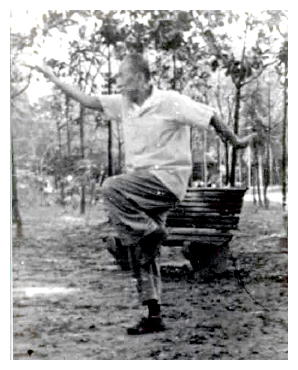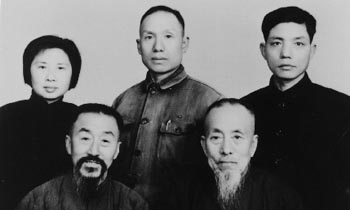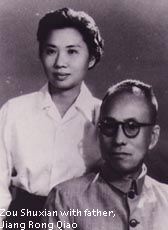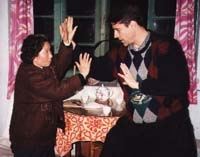(Xingyiquan and Hsing I Ch'uan are different English translation schemes for the same "Form and Will Fist" martial art.) Also see:
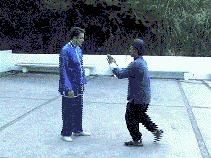
Introduction to Xingyiquan (page 2)
by Gerald A. Sharp
Animated picture: San Cai Shi ("Three Bodies" Posture) Application against a lapel grab. The beginning form of Xingyiquan, or San Cai Shi, has a variety of applications and usages. Supposedly, from this one, seemingly, simple form the entire contents of Xingyiquan can be practiced and realized.
The martial art of Xingyiquan is organized into two basic groupings: Five Phases (or Five Elements) and Animal systems. The Five Phases are a described below, but they are largely used to characterize actions and organize change in the form of two progressions, one constructive and one destructive. A discussion of the historical and philosophical development of the Five Phases follows below in page 2 of Introduction to Xing Yi Quan (Hsing I Ch'uan) on the chiflow website. The foundation of Xingyiquan is the implementation of the Five Phases as Five Fists. From this foundation, the development of Xingyiquan has split into two different main styles of Xingyiquan which are Ten Animals style and Twelve Animals style. A discussion of the Ten Animals style and the Twelve Animals style can be found on page 1 of the Introduction to Xing Yi Quan (Hsing I Chuan) on the chiflow website. Examples of Xingyiquan Twelve Animal style Applications can be found on this web site.
|
1. The Five Phases (or Five Elements)
Xingyiquan's basic approach is rooted in the Five Phases which were first identified with 5 stars in the sky. This association is a traditional way of categorizing movement, "energy" and relationships. This ancient categorization relates the properties attributed to these five stars with seasonal changes and atmospheric influences. Such ideas were first recorded in ancient texts including "The Yellow Emperor's Classic of Medicine" and the "Hua Hu Ching." |
2. The Five Phases (or Five Elements) Continued
Mastering Xingyiquan requires a deep understanding of the basic properties and shapes in terms of the Five Phases. The association with Xingyiquan is organized as follows: Metal splits, Wood bursts forth, Water drills, Fire explodes, Earth crosses over. This organizational structure supports efficiency. Like other internal martial arts such as Baguazhang and Taijiquan, efficiency in practice is paramount. Of all these Chinese internal martial arts, Hsing-I is perhaps the easiest system to turn from an internal art to an external art. Much of the Xingyiquan that is taught everywhere - including China - follows this external martial arts path. It is not the path that original source materials and best traditions point to as the direction to reach high levels of skill in Hsing-I Ch'uan. 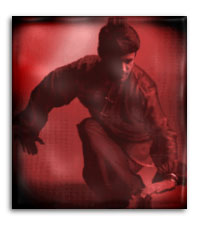 |
|
3. Xingyiquan As An Internal Art
When Taijiquan was unveiled publicly in 1911 in Beijing, many Xingyi Masters wondered what the big deal was since they had been practicing their version of internal arts for decades already. A great deal of credit is owed to Sun Lutang who brought together internal martial artists of all three branches, and popularized the concept of Nei Jia Kung Fu (or, Internal Martial Arts). Also the Kuoshu Institute in Nanjing brought together many internal and external martial artists, and developed an advanced training academy. Xingyi was able to maintain its own identity and continue to grow in popularity. Now, like then, it was characterized by simple movements which focused on efficiency and precision. From the onset, this approach allows the practitioner to engage in developing internal energy and power by simply following the movements of an opponent, and overcoming force with softness and the process of relaxation instead of meeting force with force.
Above: A San Cai Shi ("Three Bodies Posture") application utilizes a calf crush to neutralize and reverse a frontal attack. On the obvious level, the applications look much like a striking art such as Western boxing. On the hidden (or intermediate) level, the application of the art resembles traditional Chinese Suai Jiao (a grappling martial art similar to Judo, Jiu-Jitsu, or Wrestling). However, on the Transformational (or, Advanced) level, the application looks like nothing at all, much like the application of Advanced Taijiquan. (Like Taijiquan and Baguazhang, Xingyiquan advanced applications sometimes appear to be fake and contact is needed to determine if the practice is real.) Very skilled advanced level practice can seem almost like magic. One of the ways of developing this level of skill is through the practice of Xingyi Tui Shou (or, Push Hands). Another component is the traditional Xingyi practice olf Zhanzhuang (or, standing meditation). Above: A San Cai Shi ("Three Bodies Posture") application is also a valid Splitting Fist or Eagle/Bear Application. |
4. Modern Developments of Xingyiquan - Yiquan
One of the most popular developments of Xingyi Zhanzhuang in recent times is Dachengquan and the rediscovery of Yiquan. Accordingly Wang Xiangzhai expanded the teachings of Zhanzhuang from his teacher Guo Yunshen to new heights. Instead of the zhanzhuang postures being at the center of Xingyiquan practice, Wang Xiangzhai saw these inner jewels either slipping away or being eliminated from the practice altogether. Furthermore, he felt that core practices of applications, push hands, and sparring also were increasingly absent. Holding some of the Yiquan and Zhanzhaung postures at the forefront of his practice and keeping application of the art central, Wang developed a new Nei Jia Kung Fu art known as Dachengquan. It should be noted, that the idea of focusing on finding motion within stillness, fajing (or explosive force) within subtle forms of energy, or sound or vibration within emptiness was not a new idea that began with Wang. In fact, legendary accounts of Wang's teacher, Guo Yunshen practicing fa-jing from a standing position, while engrossed deeply in meditation are well documented. One account discusses how an imprisoned Guo Yunshen broke the chains that held him, while being immersed in meditation and releasing fa jing with beng chuan (bursting fist).
|
|
5. Jiang Rong Qiao
Liu Qi Lan taught Zhang Zao Dong (Chang Chao-tung AKA Zhang Zhankwei) and Li Cun Yi. Jiang Rong Qiao, sometimes spelled Chiang Yung Ch'iao (1890-1974), was a student of both Zhang Zao Dong and Li Cun Yi. Primarily his studies in both Pa-Kua Chang and Hsing-I Chuan are attributed to Zhang Zao Dong. However, one of Jiang Rong Qiao's top Hsing-I Chuan students does credit Li Cun Yi as being Jiang Rong Qiao's most influential Hsing-I teacher. As a child he studied a variety of martial arts and weapons including Mi Zhong Chuan style of Kung Fu. Jiang Rong Qiao was one of the most influential Chinese Internal Martial Arts teachers and authors of the Twentieth Century. It is likely that the combined Xingyiquan (Hsing I Ch'uan) and Baguazhang (Pa Qua Chang) "Nei Jia kung fu" system that Jiang Rong Qiao developed and taught is probably still the most widely practiced in China and very likely the world. |
6. Five Teachers
The photo above shows my Hsing-I (and Pa Kua) teacher, top row left, Zou Shuxian. Top from right is Ji Yuan Song and Yang Bantai. Bottom left is Sha Guozhen and bottom right is the great Hsing-I and Pa Kua Master, Jiang Rong Qiao.
The version of the (Hebei) Twelve Animals style that is presented on Chiflow.com and in the videos at the online store has been passed down from the teachings of Liu Qi Lan. The instruction has been passed down through the following teachers: Liu Qi Lan
|
|
7. Zou Shuxian
The photo above shows my Hsing-I (and Pa Kua) teacher, Zou Shuxian and the great Pa Kua Master, Jiang Rong Qiao. The image below is Zou Shuxian with Gerald A. Sharp.
|
8. Application Examples
Examples of Xing-yi (Hsing I) applications appear above and elsewhere on this site as annimated images or video files. (We plan on adding more applications in the future.) This Jiang Rong Qiao style of Hsing-I Ch'uan is organized using 12 Animals that group and teach the martial characteristics of particular actions. On a fundamental level, Hsing I is built on "Five Elements" (or "Five Phases") that provide a system for categorizing and understanding the relationships between types of actions. We have divided the applications between the "Introduction to Xingyiquan" page and the "Hsing I Ch'uan Overview" page. We have other Chinese internal martial art resources available on the main site and the store.
|

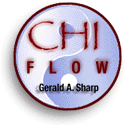

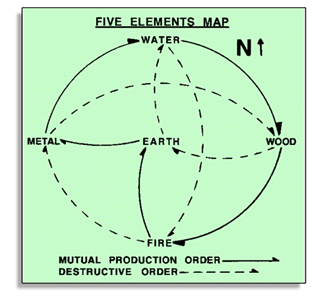
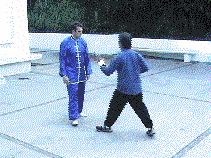
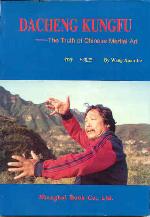 Since the creation of Xingyiquan, one of the pillars of practice is that of Standing Meditation. Because the idea of stilllness within motion was so counterintuitive, the idea of motion within stillness was even more difficult to assimilate. However, in my opinion, Xingyi would not have survived to this day without it. Just standing within postures of each of the Five Fists can provide a deeper sense of structure and an avenue for absorbing and circulating internal energy.
Since the creation of Xingyiquan, one of the pillars of practice is that of Standing Meditation. Because the idea of stilllness within motion was so counterintuitive, the idea of motion within stillness was even more difficult to assimilate. However, in my opinion, Xingyi would not have survived to this day without it. Just standing within postures of each of the Five Fists can provide a deeper sense of structure and an avenue for absorbing and circulating internal energy.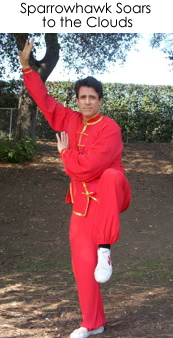 Because of Wang's efforts Yiquan has been rediscovered, and the internal practice of standing meditation has been recreated in styles that have suffered from faulty transmissions in recent times. However, just because Wang emphasized standing and deemphasized traditional Xingyi forms practice, doesn't mean this is the way for everyone to practice or advance. It is probably inadvisable for a novice to drop the very foundation by which such advances were made.
Because of Wang's efforts Yiquan has been rediscovered, and the internal practice of standing meditation has been recreated in styles that have suffered from faulty transmissions in recent times. However, just because Wang emphasized standing and deemphasized traditional Xingyi forms practice, doesn't mean this is the way for everyone to practice or advance. It is probably inadvisable for a novice to drop the very foundation by which such advances were made. 